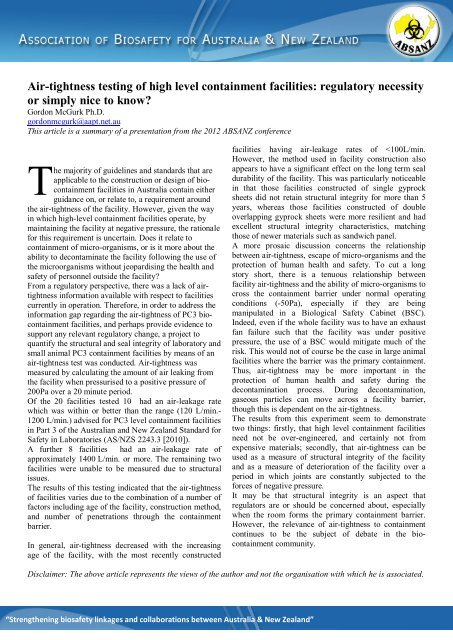Newsletter Issue 01 June 2013 - absanz
Newsletter Issue 01 June 2013 - absanz
Newsletter Issue 01 June 2013 - absanz
You also want an ePaper? Increase the reach of your titles
YUMPU automatically turns print PDFs into web optimized ePapers that Google loves.
Air-tightness testing of high level containment facilities: regulatory necessity<br />
or simply nice to know?<br />
Gordon McGurk Ph.D.<br />
gordonmcgurk@aapt.net.au<br />
This article is a summary of a presentation from the 2<strong>01</strong>2 ABSANZ conference<br />
T<br />
he majority of guidelines and standards that are<br />
applicable to the construction or design of biocontainment<br />
facilities in Australia contain either<br />
guidance on, or relate to, a requirement around<br />
the air-tightness of the facility. However, given the way<br />
in which high-level containment facilities operate, by<br />
maintaining the facility at negative pressure, the rationale<br />
for this requirement is uncertain. Does it relate to<br />
containment of micro-organisms, or is it more about the<br />
ability to decontaminate the facility following the use of<br />
the microorganisms without jeopardising the health and<br />
safety of personnel outside the facility?<br />
From a regulatory perspective, there was a lack of airtightness<br />
information available with respect to facilities<br />
currently in operation. Therefore, in order to address the<br />
information gap regarding the air-tightness of PC3 biocontainment<br />
facilities, and perhaps provide evidence to<br />
support any relevant regulatory change, a project to<br />
quantify the structural and seal integrity of laboratory and<br />
small animal PC3 containment facilities by means of an<br />
air-tightness test was conducted. Air-tightness was<br />
measured by calculating the amount of air leaking from<br />
the facility when pressurised to a positive pressure of<br />
200Pa over a 20 minute period.<br />
Of the 20 facilities tested 10 had an air-leakage rate<br />
which was within or better than the range (120 L/min.-<br />
1200 L/min.) advised for PC3 level containment facilities<br />
in Part 3 of the Australian and New Zealand Standard for<br />
Safety in Laboratories (AS/NZS 2243.3 [2<strong>01</strong>0]).<br />
A further 8 facilities had an air-leakage rate of<br />
approximately 1400 L/min. or more. The remaining two<br />
facilities were unable to be measured due to structural<br />
issues.<br />
The results of this testing indicated that the air-tightness<br />
of facilities varies due to the combination of a number of<br />
factors including age of the facility, construction method,<br />
and number of penetrations through the containment<br />
barrier.<br />
In general, air-tightness decreased with the increasing<br />
age of the facility, with the most recently constructed<br />
facilities having air-leakage rates of


